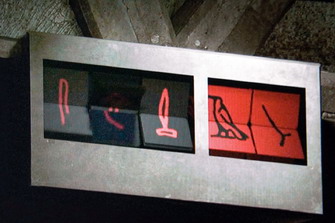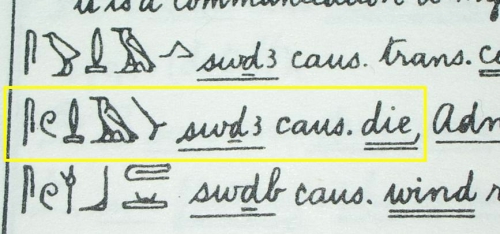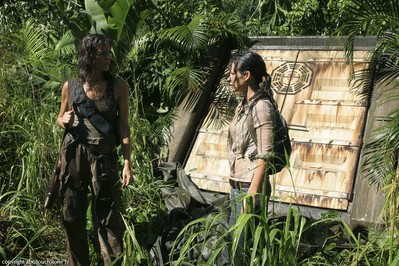That picture of the hatch counter from last week’s promo wasn’t from tonight’s episode, that’s for sure. Regardless, the counter finally did reach zero, and we got a great look at some hieroglyphs and the sounds of “something” powering up. I’m not sure why I keyed on this, but the floor of the armory Sayid was torturing Mr. Balloon in looked similar to that of an aircraft’s cargo bay (like a C-130 transport). Is the island actually a ship of some kind? A submarine? An aircraft?
The counter itself:

Using the handy-dandy hieroglyph translator here, we get:
 s (saw) //
s (saw) //  100 (coiled rope) // ? //
100 (coiled rope) // ? //  ah (father) // ?
ah (father) // ?
Someone on ABC’s message boards came up with this, but as the second glyph is missing from the episode, it’s open for debate, but it appears like it’s going to stop at what appears below:

So, to sum all this up, it clearly spells: “POOPY.”
But, really, it translates to something like “CAUSE TO DIE.” Is someone gonna get sick next episode?
News and notes:
- Name of the “Other/balloon man:” Henry Gale. There’s a certain, famous Dorothy with the same last name; who, if memory serves, left a land called Oz in a hot air balloon…
- We now know why Hurley has stayed his jolly, rotund self: ranch dressing.
- The code on the videotape Clancy Brown showed Sayid: 23108-42 (23, 42, sum 108).
- If the picture at the end wasn’t enough to let you know, the soldier Sayid was with was Kate’s father. Remember, we saw Sayid in a video in his recruiting office in one of the Kate-centric episodes a while back.
- We see evidence of another station in the promo for the next new episode. The obvious conclusion would be that it’s some kind of medical station, because of the caduceus.
A staff or rod with a snake curled around it is the staff (the rod) of Aesculapius (also called Asklepios), the ancient mythical god of medicine. His Greek name was Asklepios and his Roman name was Aesculapius. In reality, Asklepios may have once lived and been renowned for his gentle, humane remedies and his humane treatment of the mentally ill. His followers established temples called asclepions, temples of Asklepios, temples of healing. The greatest asklepion was in a grove of trees south of Corinth, Greece where the sick had to spend a night while the proper remedies were revealed during a dream to the priests of the temple and the cured had to make a suitable sacrifice (usually a rooster) to the god.
Couple this with the earlier reference to someone getting sick or dying in the counter glyphs. Is that sick “someone” going to need medical attention? How handy would a medical station be?
- There also appeared to be a flash of a door labeled “Escape Hatch.” Is the medical station some sort of ship itself? A plane?
- When Hale mentioned that he went to the University of Minnesota, I immediately thought back to the Dharma Intiative video and Gerald de Groot’s alma mater. Alas, that was the University of Michigan.
- Speaking of the good Doctor de Groot, Wikipedia yields the following:
Adriaan de Groot (born 1914) is a Dutch chess master and psychologist conducted some of the most famous chess experiments of all time in the 1940s-60. 1965 saw the publication of his book Thought and choice in chess.
The studies involve participants of all chess backgrounds, from amateurs to masters. They investigate the cognitive requirements and the thought processes involved in moving a chess piece. The participants were usually required to solve a given chess problem correctly under the supervision of an experimenter and represent their thought-processes vocally so that they could be recorded.
De Groot found that much of what is important in choosing a move occurs during the first few seconds of exposure to a new position. Four stages in the task of choosing the next move were noted. The first stage was the ‘orientation phase’, in which the subject assessed the situation and determined a very general idea of what to do next. The second stage, the ‘exploration phase’ was manifested by looking at some branches of the game tree. The third stage, or ‘investigation phase’ resulted in the subject choosing a probable best move. Finally, in the fourth stage, the ‘proof phase’, saw the subject confirming with him/herself that the results of the investigation were valid.
De Groot concurs with Alfred Binet that visual memory and visual perception are important attributors and that problem-solving ability is of paramount importance. Memory is particularly important, according to de Groot (1965) in that there are no ‘new’ moves in chess and so those from personal experience or from the experience of others can be committed to memory.
A short disclaimer: In case anyone’s wondering, about 60% of the above is stuff I come up with while watching the episode and Googling. The rest comes from a multitude of different sites devoted solely to Lost. Lest anyone think I’m a thief, see above disclaimer.

good stuff gordo, I love getting the breakdown of the episodes from your site. I’m way to lazy to look all that stuff up myself.